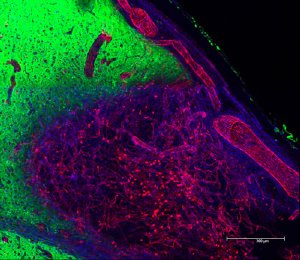Sep 3 2009
An injectable biomaterial gel may help brain tissue grow at the site of a traumatic brain injury, according to findings by a Clemson University bioengineer.
 Four weeks after hydrogel treament on a lesion in a rat’s brain, a well-structured vasculature network was rebuilt. In this mosaic image, green is neurofilament staining for neurites and red is staining for blood vessels. image by: Clemson University
Four weeks after hydrogel treament on a lesion in a rat’s brain, a well-structured vasculature network was rebuilt. In this mosaic image, green is neurofilament staining for neurites and red is staining for blood vessels. image by: Clemson University
Research by assistant professor of bioengineering Ning Zhang shows that the biomaterial gel made up of both synthetic and natural sources has the potential to spur the growth of a patient’s own neural stem cells in the body, structurally repairing the brain injury site. In previous lab studies, Zhang has demonstrated the reconstruction of a complete vascular network at the injury site as an initial step toward brain tissue regeneration.
Zhang presented her findings Wednesday, Sept. 2, at the Military Research Forum in Kansas City. The conference is geared toward improving the overall health and welfare of the U.S. armed forces, their families, veterans and the American public.
“We have seen an increase in brain injuries due to combat, but our strategy can also potentially be applied to head injuries caused by car accidents, falls and gunshot wounds," said Zhang. “These results that we are seeing in adult lab rats are the first of its kind and show a sustained functional recovery in the animal model of TBI (traumatic brain injury). It also represents one of very few in the traumatic brain injury field that attempts structural repair of the lesion cavity using a tissue-engineering approach.”
Zhang predicts the procedure may be ready for human testing in about three years.
The researcher says current approaches to traumatic brain injury have been focused on managing the primary injury using hypothermia or neuroprotection with pharmacological agents, all with limited success. With this new procedure, the hydrogel is injected into the lesion site to direct the response of neural stem cells in the brain to regenerate normal brain tissue at the lesion site. The current research is supported by a $220,000 grant from the U.S. Department of Defense.